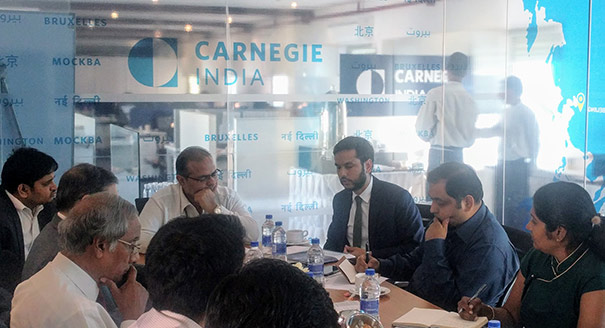Registration
Thank you!
You will receive an email confirming your registration.
The Bay of Bengal Initiative for Multi-Sectoral Technical and Economic Cooperation (BIMSTEC), founded in 1997, can help reconnect one of the world’s least integrated regions. Constantino Xavier’s new paper, Bridging the Bay of Bengal: Toward a Stronger BIMSTEC, argues that for BIMSTEC to succeed, and revive the Bay of Bengal as a link between South and Southeast Asia, its member countries (Bangladesh, Bhutan, India, Myanmar, Nepal, Sri Lanka, and Thailand) need to make the organization a priority and endow it with adequate resources.
Carnegie India hosted a private roundtable discussion on the paper to assess the current state of cooperation in the Bay of Bengal region and also to gather views, from India and other countries in the region, on strengthening connectivity through BIMSTEC and other initiatives.
Discussion Highlights
- The Bay of Bengal’s Reemergence: Participants traced the evolution of the Bay of Bengal from a thriving economic and cultural hub till into the 1950s to one of the least integrated regions in the world today. This lack of connectivity, one participant noted, is reflected in India’s negligible land-based trade with Myanmar, which is equivalent to its total trade with Nicaragua. The discussion focused on how countries in the region are now focusing on developing their infrastructure to connect with each other and explore the advantages of greater interdependence. For the Himalayan landlocked countries of Nepal and Bhutan, for example, access to the Bay of Bengal increases their developmental prospects, participants noted. They explained that since many of these connectivity imperatives transcend the bilateral level, regional organizations such as BIMSTEC can play a crucial facilitating role and create new multilateral habits of cooperation across the region. Finally, participants also noted how the Bay of Bengal is assuming greater strategic importance, located at the heart of the Indo-Pacific region.
- Empowering the Institution: Participants noted the pressing need to empower BIMSTEC with more institutional capacity, including greater financial and human resources. They highlighted said that since the BIMSTEC Secretariat was established in 2014 in Dhaka, it has been unable to adequately contribute to the development of the organization, and its negligible budget affects its capacity to perform a basic convening function. While the organization has only conducted three summits in the last 20 years, participants stated, the increasing interest in the region provides BIMSTEC with the perfect opportunity to pitch for more resources in order to realize the organization’s mandate and serve the member-countries’ interests of its member countries.
- Recommendations: Participants discussed the paper’s recommendations on how best to empower BIMSTEC to develop regional connectivity, foster a sense of common belonging in countries across the region, and work towards reestablishing a Bay of Bengal community. To achieve these objectives, participants agreed, BIMSTEC should be seen as one of many complementary platforms and coordinate with other initiatives, including the BBIN or various country partnerships with ASEAN. Participants also discussed whether BIMSTEC should focus on a broad range of issues covered in its fourteen working groups, or if it should narrow its focus to a few priority areas, including cooperation on non-traditional security issues.
- Political Challenges: Beyond the lack of a stronger institutional framework for BIMSTEC to pursue its mandate, participants also identified a variety of other challenges the organization is likely to face in future. One main obstacle refers to the overlapping mandate with SAARC , which was put on hold after the summit cancellation in 2016. Participants also noted with concern the fact that under Nepal’s chairmanship, the fourth BIMSTEC summit has been repeatedly delayed and failed to take place in 2017, the organization’s twentieth anniversary. Participants further discussed how bilateral conflict can derail BIMSTEC’s efforts to foster regional cooperation. They observed how the current Rohingya refugee crisis has complicated relations between Bangladesh and Myanmar and how such bilateral tensions could may affect multilateralism.
- India’s Role: Some participants argued that, from India’s perspective, BIMSTEC should be given priority, as it aligns with the country’s “Act East” policy. All participants were in agreement regarding the disproportional role of India in BIMSTEC. As the largest and most vibrant economy in the region, many nations are now comfortable with India’s ambition to take a leading position, stated participants. They emphasized the need for India to deliver on growing expectations, in particular since it hosted the BIMSTEC Leaders’ Retreat, in 2016. Participants also noted with concern the fact that under Nepal’s chairmanship, the fourth BIMSTEC summit has been repeatedly delayed and failed to take place in 2017, the organization’s twentieth anniversary. Participants further discussed how bilateral conflict can derail BIMSTEC’s efforts to foster regional cooperation. They observed how the current Rohingya refugee crisis has complicated relations between Bangladesh and Myanmar and how may affect multilateralism.
This event summary was prepared by Rhea Menon, an intern at Carnegie India.
